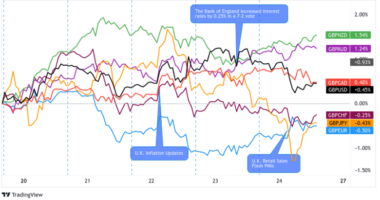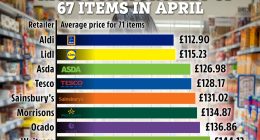When the Reserve Bank of Australia (RBA) met on its monetary policy today, many analysts were unsure of how things would pan out with interest rates given the recent drop in CPI among other things.
Eventually, after 10 straight hikes in the Official Cash Rate, the RBA has decided to hold steady at 3.6%, for the time being. The interest rate on Exchange Settlement balances has also remained unchanged at 3.5%.
The Board also used the occasion to emphasize how robust, well-capitalized, and highly liquid the Australian banking sector presently is and how well-positioned it is to provide the credit that the economy requires.
It’s a worthy reminder after the recent unrest in the US and Europe, where a few large banks experienced distress and/or failed.

AUD/USD Daily Chart – Source: ActivTrades’ online trading platform
Headline global inflation trending down but still too high
Governor Lowe, in his statement, suggested that the rate of inflation throughout the world is still rather high.
While overall price increases for services continue to be strong in many countries, the headline rate of inflation is showing signs of moderation.
He indicated that the forecast for the global economy is not looking particularly bright, with below-average growth anticipated both this year and next.
Inflation for Australia, however, was down in February, according to data issued by the Australian Bureau of Statistics on March 16th. Compared to January’s 7.4%, the current level of 6.8% for the 12 months to February suggests the RBA’s rapid rate raise regime may be having the desired effect. Hence the current pause.
Future growth is predicted to be below trend for at least the next two years, according to the RBA. The combination of rising interest rates, the rising cost of living pressures, and falling property values have been shown to significantly slow down consumer spending, and the economy is definitely not as hot as it once was.
Although some families have comfortable financial cushioning, others are under a severe financial pinch.
The Board reminded that it is aware that there will be a delay before the significant rises in the past year are fully felt because of the way monetary policy works with a “lag.”
It advised that they had decided to keep rates unchanged this month to give more time to evaluate how the economy will respond and the prospects for the future.
Welcome news for some mortgage holders, but many are already in trouble
Over 900,000 Australians are poised to face a “fixed-rate mortgage cliff” as a result of taking up low-interest mortgages during the economic stimulus period of the pandemic.
As part of its reaction to the economic repercussions of Covid-19, the RBA offered banks access to three-year fixed-rate credit, which the banks in turn passed on to borrowers in the form of inexpensive three-year loans.
Borrowers who took advantage of these loans during that time are now experiencing, or will soon begin experiencing, the impact of the RBA’s string of consecutive rate hikes over the course of the last 10 meetings, which have caused the once-record low fixed interest rates to become much higher variable rate loans.
Almost 880,000 Australians will have their fixed-rate loans expire by the end of 2023.
This could result in a significant increase in monthly payments for certain borrowers, and many may not even be able to refinance due to the lack of equity left in their property since the property market has subsequently taken a dive.
In the meanwhile, rents are rising faster than they have in recent years, and vacancy rates remain low throughout most of the nation.
According to its most recent report, published on April 3rd, the National Housing Finance and Investment Corporate (NHFIC) conservatively estimates that 377,600 families are in need of housing, including 331,000 households facing rental hardship and 46,500 households experiencing homelessness.
There are 208,200 families with severe mental stress and 577,400 households with less severe rental hardship throughout the nation.
Will rising global fuel prices impact Australian inflation and future interest rate decisions?
Just this week, motorists have been warned that since OPEC+ decided to reduce their global oil supply by over a million barrels per day, they may ultimately pay more at the pump than they otherwise would have.
As a result, this may negatively impact the progress being made to bring inflation back to the target range and cause interest rates to stay higher for longer.
The group of major oil-producing countries, headed by Saudi Arabia, stated they would each drop output by around 5% in a decision that surprised Western governments on the 2nd of April.
In addition to reducing consumer buying power, rising oil prices will affect the cost of production and other transportation. As crude oil is a vital economic resource, its price has a significant impact on inflation, and will undoubtedly be on the radar of the RBA for future policy decisions.
Historically, production costs have been more susceptible to variations in oil prices than service costs, and because of this, crude oil has a greater relationship with the producer price index than with the consumer price index.
Eventually, though, rising producer prices will inevitably result in greater costs to consumers; the impact might be delayed but is usually unavoidable.
The RBA believes that more monetary policy tightening may be necessary to eventually bring inflation back down to the target level of 2%. Particularly in light of the substantial uncertainties surrounding the economy and its prospects lately, and now this added hiccup of unexpectedly higher costs of energy, it seems to have become entirely certain.
The information provided does not constitute investment research. The material has not been prepared in accordance with the legal requirements designed to promote the independence of investment research and as such is to be considered to be a marketing communication.
All information has been prepared by ActivTrades (“AT”). The information does not contain a record of AT’s prices, or an offer of or solicitation for a transaction in any financial instrument. No representation or warranty is given as to the accuracy or completeness of this information.
Any material provided does not have regard to the specific investment objective and financial situation of any person who may receive it. Past performance is not a reliable indicator of future performance. AT provides an execution-only service. Consequently, any person acting on the information provided does so at their own risk.








